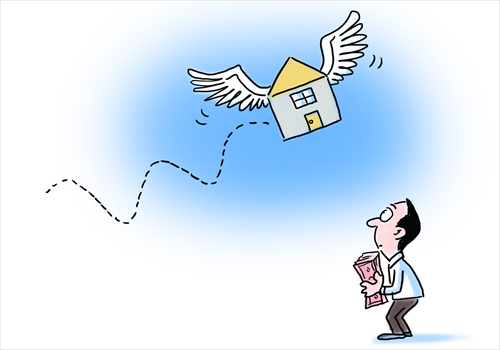After the Spring Festival, many first and second tier cities have demonstrated a spree of panic house buying, too abnormal to do any good to the healthy development of the home industry.
According to Beijing Morning Post, new homes in a Hangzhou living community were sold out two hours after they were opened for sales, 352 luxurious villas at least costing 10 million yuan each in Shanghai were snapped up within one day, and frenetic home buyers in Shenzhen and Nanjing were queuing up overnight to obtain a buying quota.
Coinciding with panic buying, new home prices in 61 cities out of the 100 sampled cities grew slightly in February, and the figures in Shenzhen and Wuhan specially accreted by 52.55% and 16.31% respectively. Media coverage and industry data both allude to a seemingly inevitable trend: the property market is picking up with a gaining momentum.
However, a dubious wait-and-see mood is also diffusing among home buyers, many of whom firmly believe that home prices hike in first-tier cities never represent the status quo of national home market in general and home buyers should be conscientious.
Various expectations toward the future of Chinese home industry is a good sign, because it means more and more people are not following the trend, but making decision by their own. But where the Chinese house market is heading for? It is a question haunting many home buyers. The future can only be explored by better understanding the present, hence figuring out reasons behind the recent panic buying is of great significance.
The panic buying, on one hand, is a knee-jerk reaction to the favorable home-buying macroeconomic policies. Since the Central Economic Working Conference in December, reducing unsold houses has been listed as one of the five kernel economic tasks in 2016. So after the Spring Festival, minimum down payment rate for buying the first and second home in cities without home buying restrictions has been narrowed down to 20 percent and 30 percent respectively, and home buying tax rate for purchasing the first home under 90 square meters has been cut back to 1.5 percent.
These policies, having almost excluded home buyers in first-tiers cities from benefiting from them, undoubtedly offer unprecedented supports to people in the 3rd and 4th tier cites, desperate for buying their first homes or improving their current living standards. Ironically, the home market in the 3rd and 4th tier cities hasn’t bounded back and oversupply burden still lingers, while home prices in the 1st tier cities have propped up because of the shrinking land lot supplies in these cities and the expectation that home buying restrictions will possible be lifted in the coming months.

On the other hand, the recent monetary ease has also contributed to panic buying. Central Bank of China has continually reduced interests rate and deposit reserve ratio to support real economic, albeit most new bank loans have flown into the home industry in mega cities, because homes prices there are more immune to market fluctuation. In January, new bank loan amounted to 2.51 trillion yuan, 1.04 trillion more than last January. Nevertheless, the PMI stagnated under 50 in January, a receding indicator of real economy.
With the help of monetary ease, many home buyers in the first tier cities, in addition to obtaining bank loans much easier than before, are borrowing either from their relatives and friends in the form of fundraising or from the third-party P2P companies with a high interest rate to buy houses for making profits, in which a long fragile debt chain is formed. Once home prices don’t grow satisfying the market expectation, these home buyers can’t make profits at all, let alone paying high interest rates to their lenders. Because of the high risk, some P2P companies involving loaning in real estate industry in the first-tier cities have either turned insolvent or been ordered to drop out.
The encouraging policies and the monetary ease, instead of reducing home inventories in the 3rd and 4th tier cities, have eventually expedited to channel money into the real estate industry in mega cities, which has resulted in the abnormal panic buying. The deviation regarding home policies implementation should serve as a wakeup call to the government’s efforts to restructure the chaotic home market: every city should have its own specified housing policies, and one packaged solutions for all cities can’t work effectively.
The home de-stocking process will be a long uphill battle, but the right methods lie in that: For the first-tier cities, tight control over home buying should continue to be applied to, because excessive home price hikes is counterproductive to their economic transformation, and for 3rd and 4th tier cities, a large number of unsold homes should be cleared with tailored policies, because there are still hundreds of millions of migrant workers with considerable purchasing power waiting to be recognised as citizens.







Comment